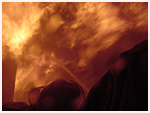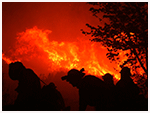« Arson Fires at 1737 E. 7th Street & 1441 E. 7th Street | Home | Long Beach Firefighter’s Memorial Association 4th of July Fireworks Show »
New Law Requires Carbon Monoxide Detectors in Homes
By Steve Yamamoto | June 16, 2011
Starting July 1, 2011 new legislation will go into effect requiring homeowners to install carbon monoxide detectors in every California home; a move CAL FIRE officials say will save lives. “Carbon monoxide is a silent killer, each year claiming the lives of an average of 480 people,” said Acting State Fire Marshal Tonya Hoover. “And sending more than 20,000 people to emergency rooms across the nation.” Carbon monoxide (CO) is a colorless, odorless gas that is produced from heaters, fireplaces, furnaces and many types of appliances and cooking devices. The best way for homeowners to stay protected from CO is to have a carbon monoxide detector installed on every floor and outside each sleeping area. A recent study found that nearly nine in 10 California households did not have a CO detector. “We encourage all of our Long Beach residents to comply with this new law to protect their families and loved ones from this potentially lethal hazard,” said Deputy Chief Jeff Reeb. Though previous laws only required newly-constructed homes to have CO alarms, the state’s new Carbon Monoxide Poisoning Prevention Act (Senate Bill 183) requires owners of all existing single-family homes with an attached garage or a fossil fuel source to install CO alarm devices within the home by July 1, 2011. Owners of multi-family leased or rental dwellings, such as apartment buildings, have until January 1, 2013 to comply with the law.
Carbon Monoxide Can Be Deadly
You can’t see or smell carbon monoxide, but at high levels it can kill a person in minutes. Carbon monoxide (CO) is produced whenever any fuel such as gas, oil, kerosene, wood, or charcoal is burned. If appliances that burn fuel are maintained and used properly, the amount of CO produced is usually not hazardous. However, if appliances are not working properly or are used incorrectly, dangerous levels of CO can result. Hundreds of people die accidentally every year from CO poisoning caused by malfunctioning or improperly used fuel-burning appliances. Even more die from CO produced by idling cars. Fetuses, infants, elderly people, and people with anemia or with a history of heart or respiratory disease can be especially susceptible. Be safe. Practice the DO’s and DON’Ts of carbon monoxide.
CO Poisoning Symptoms
Know the symptoms of CO poisoning. At moderate levels, you or your family can get severe headaches, become dizzy, mentally confused, nauseated, or faint. You can even die if these levels persist for a long time. Low levels can cause shortness of breath, mild nausea, and mild headaches, and may have longer term effects on your health. Since many of these symptoms are similar to those of the flu, food poisoning, or other illnesses, you may not think that CO poisoning could be the cause.
Prevent CO Poisoning
Play it Safe – If you experience symptoms that you think could be from CO poisoning:
• CALL 911 or your local emergency number.
• GET FRESH AIR IMMEDIATELY. Open doors and windows, turn off combustion
appliances and leave the house.
• DO NOT re-enter the premises until cleared by emergency personnel.
• GO TO AN EMERGENCY ROOM and tell the physician you suspect CO poisoning.
If CO poisoning has occurred, it can often be diagnosed by a blood test done soon after exposure.
Safety Tips
Follow these guidelines to help keep your family safer.
• Install CO alarms outside each sleeping area and on every level of the home including the basement. The CO alarm can warn you if too much CO is in your home.
• Keep CO alarms clear of dust and debris.
• Ensure CO alarms are plugged all the way into a working outlet, or if battery operated, have working batteries.
Prevention is the Key to Avoiding Carbon Monoxide Poisoning
DO have your fuel-burning appliances — including oil and gas furnaces, gas water heaters, gas ranges and ovens, gas dryers, gas or kerosene space heaters, fireplaces, and wood stoves – inspected by a trained professional at the beginning of every heating season. Make certain that the flues and chimneys are connected, in good condition, and not blocked.
DO choose appliances that vent their fumes to the outside whenever possible, have them properly installed, and maintain them according to manufacturers’ instructions.
DO read and follow all of the instructions that accompany any fuel-burning device. If you cannot avoid using an unvented gas or kerosene space heater, carefully follow the cautions that come with the device and keep doors to the rest of the house open. Crack a window to ensure enough air for ventilation and proper fuel-burning.
DON’T idle the car in a garage — even if the garage door to the outside is open. Fumes can build up very quickly in the garage and living area of your home.
DON’T use a gas oven to heat your home, even for a short time.
DON’T ever use a charcoal grill indoors — even in a fireplace.
DON’T sleep in any room with an unvented gas or kerosene space heater.
DON’T use any gasoline-powered engines (mowers, weed trimmers, snow blowers, chain saws, small engines or generators) in enclosed spaces.
DON’T ignore symptoms, particularly if more than one person is feeling them. You could lose consciousness and die if you do nothing
For further information, please visit the CAL FIRE website at www.fire.ca.gov
Deprecated: Function link_pages is deprecated since version 2.1.0! Use wp_link_pages() instead. in /home/firechan/public_html/blog/wp-includes/functions.php on line 6121
Topics: News, Public Safety | 25 Comments »
Comments are closed.


